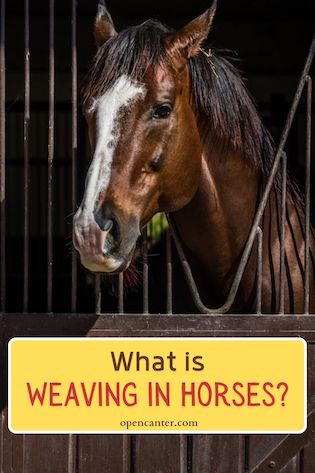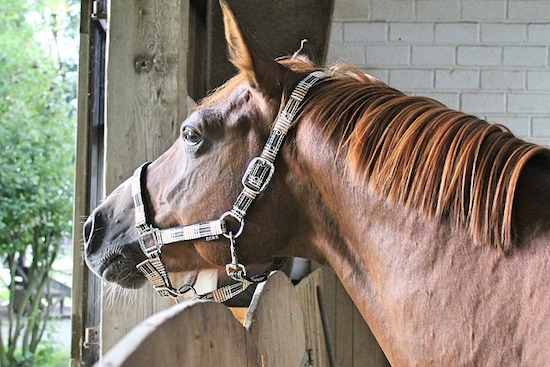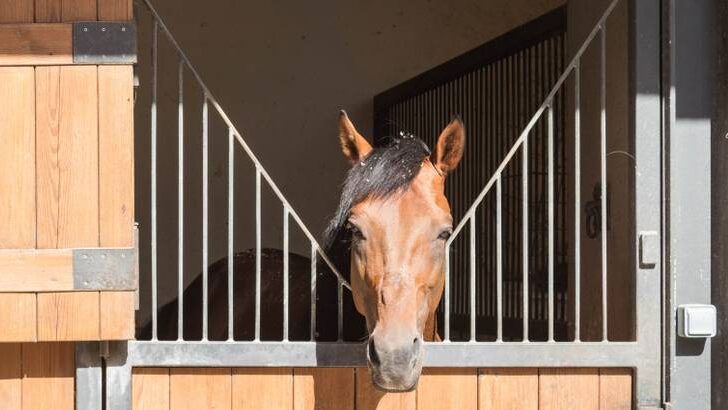Affiliate Disclaimer
As an Amazon Associate I earn from qualifying purchases. It helps me keep the website going. Thank you for your support.
Horses can develop many so-called stable vices or undesired behaviors. These behaviors usually develop due to boredom or stress and can be corrected. Weaving is one of the more common ones. What is weaving in horses?
Weaving is when a horse sways their head, neck, and or body laterally in a repeating pattern. Horses often weave and walk around their stall in the same repetitive way. Weaving can be caused by boredom, isolation, and stress. Common treatments include regular exercise and pasture time with herd mates.
Learning more about weaving and other vices can help equestrians be more informed. It allows a greater understanding of horses’ physical, mental, and social needs. So, read on to learn more about weaving and its impact on horses.

What is the Weaving Vice in Horses?
Weaving is when a horse repeatedly and compulsively shifts their weight and rocks their head and neck back and forth. Horses that weave appear to be in a trance. Weaving usually occurs before an arousing event (something the horse finds pleasing) like dinner time and is associated with isolation.
Causes of Weaving in Horses
Weaving develops for several reasons and is usually not caused by one single factor but by combining many factors. The most common factors that contribute to weaving are:
- Boredom- horses need mental stimulation and physical activity to stay healthy if they do not get these from their owners, they will find ways to compensate by developing vices like weaving
- Lack of socialization- horses are social animals that form relationships with members of their herd, when they are ostracised from them or pastured far away, they will turn to vices like weaving to fill the void
- Confinement- if a horse spends too much time in a stall or lives in a booth that is too small for them, it will develop anxiety and start weaving or cribbing to curb it
- Stressful daily life- horses will start weaving as a response to stress in their environment
- Changes in routine- if a horse’s schedule changes too often, it can use weaving as a way of feeling in control of its environment.
Simply put, horses weave as a way to cope with a stressful and unusual routine or living space. It helps them relieve anxiety and move around when they do not have adequate pasture time.
Leaving can also be genetic. if a foal has parents and that both engage in weaving, they will be more likely to start doing so. Horses tend to copy the behavior of herd mates.
Horses never start weaving without a reason. Monitoring and maintaining horse mental health is an overlooked part of horse care. A horse that is struggling mentally will not be able to perform at its peak.

Signs of Weaving
The most common physical sign of weaving in horses is that they are aggressive when approached at the stall door. The aggression is a sign that they are bored and or stressed. A horse is never angry without a reason.
Is Weaving Contagious?
Weaving is not contagious because it is a mental illness, not a transferable disease. It usually develops based on complex events that can happen during a horse’s younger years. Horses that live in an unsuitable environment and are poorly managed are more likely to weave.
If weaving was contagious, horses that do not have this Vice would not be able to be stalled or pastured with a horse that does.
Is Weaving Lethal or Dangerous?
Although weaving can cause health problems in the long term, it does not kill horses or put them in harm’s way.
However, that does not mean there are no negative consequences for weaving. Let’s see what negative impacts weaving can have in the next section.
Consequences of Weaving
Weaving causes joint problems, uneven hoof wear, worsened physical condition, as well as lameness and lethargy. The longer a horse weaves, the more side effects it can have. Some weaving cases are worse than others.
Weaving can also leave the neck muscles of a horse underdeveloped. if it persists over several years, horses can also experience weight loss. Weight loss indirectly leads to the loss of muscular conditioning that is built through exercise.
Since weaving is a habit, a horse that has been weaving for a long time will be harder to treat than one who has just started.
Are There Treatment Options for Weaving?
Thankfully, there are multiple ways you can lessen the severity of and or stop a horse’s weaving.
These include:
- Pasturing them with herd mates they like so that they can be social to reduce boredom and isolation
- Avoid leaving them in their stall for extended periods, even if it means giving them meals in the pasture
- Incorporate longer exercise periods into their schedule so that they are more active
- Use a slow feeder or set up multiple feeding stations to encourage movement
- Add a mirror to the stall if the horse usually eats with others
- If your horse lives alone, consider getting them a companion animal like a goat or a sheep.
These treatment options aim to keep the horse’s mind and body busy. In this way, feelings of boredom and isolation are reduced. The more stimulated a horse is, the less likely it will engage in behaviors like weaving.

How to Prevent Weaving in Horses
Weaving is prevented by ensuring that a horse has enough physical and mental stimulation. If a horse stays active and is properly socialized, they do not become bored, isolated, or combined. Boredom and isolation are precursors to weaving, so preventing them will prevent weaving. It is also important to minimize stress and make sure the horse is comfortable.
Does Weaving Impact Performance?
Weaving itself does not affect the performance of showhorses. However, the side effects of long-term weaving such as joint pain and ligament strains will impact their ability to perform.
Injuries to the leg if gone untreated can lead to a complete break. This will leave a horse unable to compete. Complete muscle tears also lead to the same fate.
Is It Okay to Buy a Horse That Weaves?
Buying a horse with a known vice is always an okay decision. However, if you think you will be unable to care for them, it is best to allow a seasoned equestrian to take them into their care.
Horses with vices are often passed over at auctions and other sale opportunities. When they are given the proper care to manage whatever advice they have, they become invaluable partners.
A known vice should not be the only reason why a prospective horse owner chooses a horse without one instead. Vices are usually not career-ending. they only become so after years of being unmanaged.
The Difference Between Weaving and Stall Walking
Weaving and stall walking are often lumped together as one vice, but they are different. Weaving is an in-place repetitive movement. Stall walking involves pacing up and down in a stall or pasture (source).
In any case, they have similar causes and can lead to the same hoof wear and joint problems.
Final Thoughts
What is weaving in horses? Weaving is a repetitive rocking behavior in horses that occurs due to stress, boredom, and isolation. It is not contagious or lethal and can be treated by increasing exercise and pasture time, incorporating slow feeders, and purchasing a companion. A horse that weaves can still be a capable sport horse.




